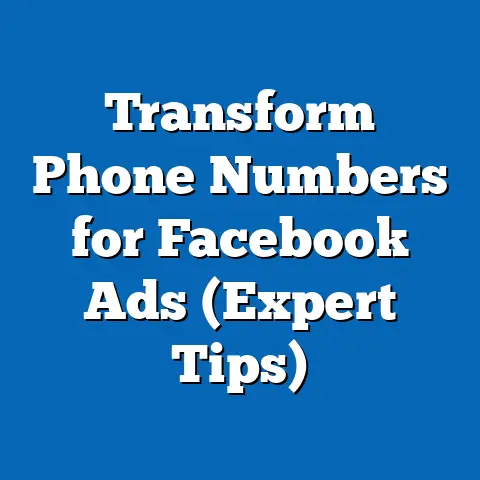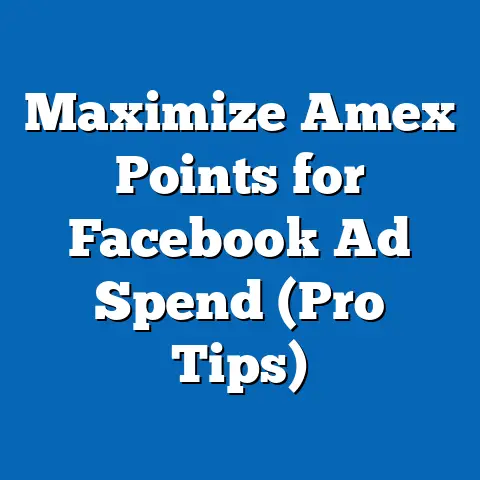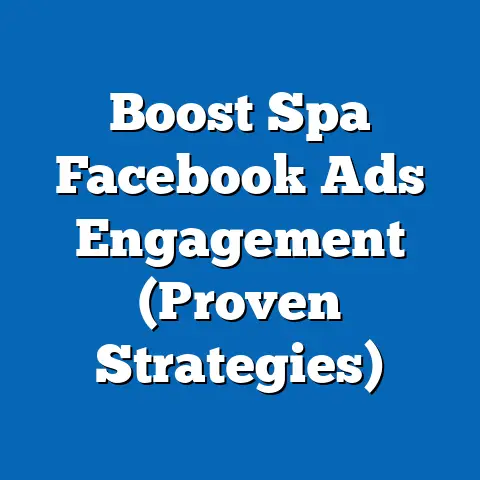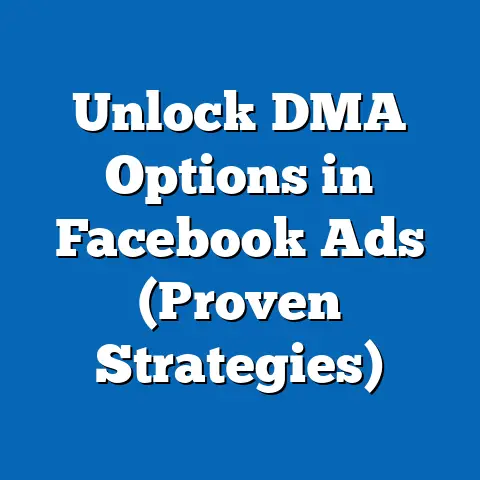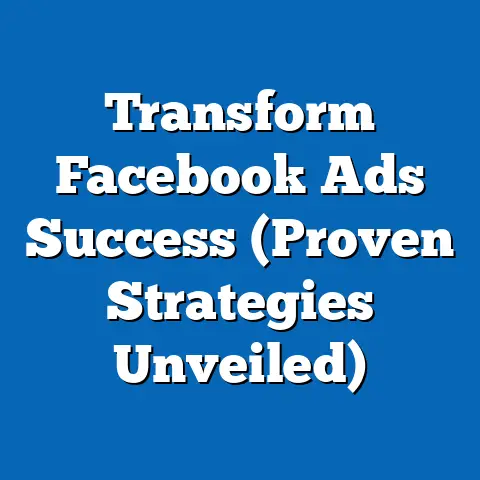Boost Clothing Brand with Facebook Ads (Expert Tips)
The scene is always vivid in my mind: a bustling clothing store, alive with the vibrant colors of the latest fashion trends. Shoppers excitedly try on outfits, their energy palpable. I remember when this was the place to be, the primary way people discovered and purchased clothing. But times have changed. Brick-and-mortar stores now face the daunting challenge of retaining attention in a digital-first world. The online marketplace has exploded, and brands must adapt to survive, let alone thrive, in this increasingly competitive environment.
In this digital age, platforms like Facebook have become pivotal for reaching potential customers effectively. I’ve seen firsthand how a well-crafted Facebook ad campaign can transform a struggling clothing brand into a thriving online business. It’s not just about throwing money at ads; it’s about understanding your audience, creating compelling content, and strategically optimizing your campaigns.
Section 1: Understanding Your Audience
Knowing your target demographic is paramount in the clothing industry. You wouldn’t market the same clothes to teenagers as you would to middle-aged professionals, right? Facebook offers a treasure trove of data through its Audience Insights tool, allowing you to delve deep into the interests, behaviors, and demographics of your potential customers. I’ve spent countless hours sifting through this data, and it’s always enlightening.
Leveraging Facebook Audience Insights
Facebook Audience Insights is your secret weapon. It provides a granular view of your audience, revealing information like:
- Demographics: Age, gender, education level, relationship status, job titles, and location.
- Interests: Hobbies, activities, pages they like, and topics they engage with.
- Behaviors: Purchase history, device usage, travel habits, and online activities.
I recall working with a small boutique that specialized in vintage clothing. They initially targeted a broad audience, assuming anyone interested in “vintage” would be a potential customer. However, after using Audience Insights, we discovered that their core audience was actually women aged 25-34, interested in sustainable fashion, art, and independent music. This revelation completely changed their ad strategy, leading to a significant increase in engagement and sales.
Here’s how to use Audience Insights effectively:
- Start with a broad audience: Begin by selecting a broad demographic, such as “Women aged 18-45 interested in fashion.”
- Analyze the data: Explore the different tabs (Demographics, Page Likes, Location, Activity, Household, and Purchase) to identify patterns and trends.
- Refine your audience: Based on your findings, narrow down your audience to target specific segments that are most likely to be interested in your clothing.
Takeaway: Don’t make assumptions about your audience. Use Facebook Audience Insights to gather concrete data and inform your ad strategy.
Creating Buyer Personas
Once you’ve gathered data from Audience Insights, it’s time to create detailed buyer personas. A buyer persona is a semi-fictional representation of your ideal customer, based on research and data about your existing and potential customers.
I like to give my buyer personas names and backstories. It helps me visualize them as real people with specific needs and desires. For example, I might create a persona named “Sarah,” a 28-year-old marketing professional who loves sustainable fashion and ethical brands. She’s active on Instagram, follows fashion bloggers, and is willing to pay a premium for high-quality, eco-friendly clothing.
Elements of a strong buyer persona:
- Name and Photo: Give your persona a name and find a representative photo.
- Demographics: Age, gender, location, income, education, and job.
- Goals and Challenges: What are they trying to achieve, and what obstacles are they facing?
- Values and Motivations: What’s important to them? What drives their purchasing decisions?
- Preferred Channels: Where do they spend their time online? What social media platforms do they use?
- Brand Relationship: Are they aware of your brand? Have they purchased from you before?
Takeaway: Buyer personas help you humanize your target audience, making it easier to create targeted and relevant ad content.
Examples of Successful Audience Targeting
Many clothing brands have successfully leveraged audience data to boost their ad performance. One example is a sportswear brand that targeted fitness enthusiasts by analyzing their interests in specific sports, gyms, and health-related pages. They created ads featuring athletes wearing their clothing, which resonated strongly with their target audience, resulting in a significant increase in sales.
Another example is a luxury brand that targeted affluent consumers by analyzing their income levels, purchase history, and interests in luxury goods and travel. They created ads showcasing their high-end clothing in exotic locations, appealing to their target audience’s aspirational desires.
Takeaway: Successful clothing brands use audience data to create highly targeted ads that resonate with their ideal customers.
Section 2: Crafting Compelling Ad Content
Creating compelling ad content is crucial for capturing attention and driving conversions. In the crowded digital landscape, your ads need to stand out and offer something valuable to your audience. I always tell my clients: “Don’t just sell clothes, sell a lifestyle.”
The Power of Storytelling
Storytelling is a powerful tool for fashion advertising. People connect with stories on an emotional level, and a well-crafted narrative can create a lasting impression. Think about iconic fashion campaigns like Chanel’s films or Ralph Lauren’s aspirational lifestyle imagery. These brands aren’t just selling clothes; they’re selling a dream.
How to weave brand narratives into your ads:
- Focus on the “why”: Why does your brand exist? What problem are you solving? What values do you stand for?
- Showcase your brand’s personality: Are you playful and quirky, or sophisticated and elegant? Let your brand’s personality shine through in your ads.
- Tell customer stories: Feature real customers wearing your clothing and sharing their experiences.
- Create a sense of community: Invite your audience to join your brand’s story by sharing their photos and stories.
I once worked with a sustainable clothing brand that told the story of their ethical manufacturing process in their ads. They showed the faces of the artisans who made their clothing, highlighting their fair wages and safe working conditions. This resonated strongly with their target audience, who valued ethical and sustainable practices.
Takeaway: Storytelling can help you connect with your audience on an emotional level, building brand loyalty and driving conversions.
High-Quality Images and Videos
In the visual world of fashion, high-quality images and videos are essential. Your ads should showcase your clothing in the best possible light, highlighting its features, fit, and style.
Tips for shooting and editing compelling visuals:
- Invest in professional photography: Hire a professional photographer who understands fashion and can capture your clothing in a flattering way.
- Use natural lighting: Natural lighting is always the most flattering. Shoot your clothing outdoors or in a well-lit studio.
- Showcase your clothing in context: Don’t just show your clothing on a mannequin. Show it being worn by real people in real-life situations.
- Use video to tell a story: Video is a powerful tool for showcasing your clothing in motion and telling a story about your brand.
- Edit your visuals carefully: Use photo and video editing software to enhance your visuals and make them look their best.
I remember a client who initially used low-quality photos of their clothing in their ads. The photos were poorly lit, blurry, and didn’t showcase the clothing’s features effectively. After investing in professional photography, their ad engagement and sales skyrocketed.
Takeaway: High-quality images and videos are essential for showcasing your clothing and capturing attention.
Utilizing User-Generated Content
User-generated content (UGC) is a goldmine for clothing brands. It’s authentic, relatable, and builds trust with your audience. Featuring real customers wearing your clothing can be incredibly powerful.
How to leverage UGC in your ads:
- Run a contest or giveaway: Encourage your customers to share photos of themselves wearing your clothing for a chance to win a prize.
- Ask for testimonials: Request testimonials from satisfied customers and feature them in your ads.
- Share customer photos on your social media channels: Repost customer photos on your social media channels, giving them credit and tagging their accounts.
- Create a hashtag: Encourage your customers to use a specific hashtag when sharing photos of themselves wearing your clothing.
I’ve seen brands successfully use UGC in carousel ads, showcasing a variety of customers wearing their clothing in different styles and settings. This creates a sense of community and shows potential customers how the clothing looks on real people.
Takeaway: User-generated content is a powerful tool for building trust, showcasing your clothing, and creating a sense of community.
Section 3: Choosing the Right Ad Formats
Facebook offers a variety of ad formats, each with its own strengths and weaknesses. Choosing the right ad format is crucial for achieving your marketing objectives. I often advise my clients to experiment with different formats to see what works best for their brand and audience.
Carousel Ads
Carousel ads allow you to showcase multiple images or videos in a single ad. Each image or video has its own headline, description, and link, allowing you to highlight different products or features.
Advantages of carousel ads for clothing brands:
- Showcase multiple products: Highlight different items in your clothing line.
- Tell a story: Use each image or video to tell a story about your brand or a specific product.
- Drive traffic to specific product pages: Link each image or video to a specific product page on your website.
I’ve seen carousel ads used effectively to showcase a complete outfit, with each image highlighting a different piece of clothing and linking to its product page.
Takeaway: Carousel ads are great for showcasing multiple products and driving traffic to specific product pages.
Slideshow Ads
Slideshow ads are video-like ads created from a series of still images. They’re a cost-effective way to create engaging video content without the expense of shooting a full video.
Advantages of slideshow ads for clothing brands:
- Cost-effective: Create engaging video content without breaking the bank.
- Easy to create: Easily create slideshow ads using Facebook’s built-in tools.
- Mobile-friendly: Slideshow ads are optimized for mobile devices, making them ideal for reaching on-the-go shoppers.
I’ve seen slideshow ads used effectively to showcase a behind-the-scenes look at a clothing brand’s design process, highlighting the craftsmanship and attention to detail that goes into their clothing.
Takeaway: Slideshow ads are a cost-effective and easy-to-create way to engage your audience with video-like content.
Collection Ads
Collection ads are a visually immersive ad format that showcases your products in a catalog-like experience. When someone clicks on a collection ad, they’re taken to a full-screen experience where they can browse your products and make a purchase.
Advantages of collection ads for clothing brands:
- Visually appealing: Create a visually immersive shopping experience.
- Easy to browse: Allow customers to easily browse your products in a catalog-like experience.
- Seamless shopping experience: Provide a seamless shopping experience that encourages conversions.
I’ve seen collection ads used effectively to showcase a complete seasonal collection, allowing customers to easily browse the entire collection and make a purchase.
Takeaway: Collection ads are a visually immersive and seamless way to showcase your products and drive conversions.
Section 4: Budgeting and Bidding Strategies
Setting an effective budget and choosing the right bidding strategy are crucial for maximizing your ROI on Facebook ads. I always advise my clients to start with a small budget and gradually increase it as they see results.
Setting an Effective Budget
Your Facebook ad budget should be based on your marketing objectives, target audience, and the cost of reaching them. There’s no one-size-fits-all budget, but here are some guidelines to follow:
- Start small: Begin with a small daily budget and gradually increase it as you see results.
- Consider your target audience: The cost of reaching your target audience will vary depending on their demographics, interests, and location.
- Set a lifetime budget: Set a lifetime budget for your campaign to avoid overspending.
- Monitor your results: Track your ad performance and adjust your budget accordingly.
I remember a client who started with a daily budget of \$10 and gradually increased it to \$50 as they saw their sales increase. They were able to effectively scale their ad spend without overspending.
Takeaway: Set a budget that aligns with your marketing objectives and allows you to test and optimize your ads.
Understanding Bidding Options
Facebook offers several bidding options, each with its own advantages and disadvantages. The right bidding option for you will depend on your campaign goals.
- Cost-per-click (CPC): You pay each time someone clicks on your ad. This is a good option if you’re focused on driving traffic to your website.
- Cost-per-impression (CPM): You pay for every 1,000 times your ad is shown. This is a good option if you’re focused on brand awareness.
- Cost-per-action (CPA): You pay when someone takes a specific action, such as making a purchase or signing up for your email list. This is a good option if you’re focused on conversions.
- Automated Bidding: Facebook automatically sets your bids to get the most results for your budget. This is a good option if you’re new to Facebook advertising.
I often advise my clients to start with automated bidding and then switch to manual bidding as they become more experienced.
Takeaway: Choose a bidding option that aligns with your campaign goals and allows you to control your ad spend.
Monitoring and Adjusting Budgets
Monitoring your ad performance and adjusting your budget accordingly is crucial for maximizing your ROI.
- Track your key metrics: Track your click-through rates, conversion rates, and return on ad spend.
- Identify what’s working: Analyze your data to identify which ads and audiences are performing best.
- Adjust your budget: Increase your budget for your best-performing ads and audiences, and decrease your budget for your worst-performing ads and audiences.
- Test new ads and audiences: Continuously test new ads and audiences to find what works best for your brand.
I’ve seen clients successfully scale their ad spend by continuously monitoring their results and adjusting their budgets accordingly.
Takeaway: Continuously monitor your ad performance and adjust your budget to maximize your ROI.
Section 5: Analyzing Performance and Making Adjustments
Analyzing your ad performance and making necessary adjustments is crucial for optimizing your campaigns and achieving your marketing objectives. I always tell my clients: “Data is your best friend in the world of Facebook ads.”
Tracking Key Metrics
Facebook Ads Manager provides a wealth of data about your ad performance. Here are some key metrics to track:
- Click-through rate (CTR): The percentage of people who saw your ad and clicked on it.
- Conversion rate: The percentage of people who clicked on your ad and completed a desired action, such as making a purchase.
- Cost per click (CPC): The average cost you pay each time someone clicks on your ad.
- Cost per conversion (CPA): The average cost you pay each time someone completes a desired action.
- Return on ad spend (ROAS): The amount of revenue you generate for every dollar you spend on ads.
I always advise my clients to set benchmarks for these metrics and track their progress over time.
Takeaway: Tracking key metrics is essential for understanding your ad performance and identifying areas for improvement.
Analyzing Data
Once you’ve gathered data about your ad performance, it’s time to analyze it and identify patterns and trends.
- Segment your data: Segment your data by ad, audience, and placement to identify which segments are performing best.
- Look for trends: Look for trends in your data to identify what’s working and what’s not.
- Identify outliers: Identify outliers in your data to understand why certain ads or audiences are performing unusually well or poorly.
I’ve seen clients discover hidden insights by segmenting their data and identifying unexpected trends.
Takeaway: Analyzing your data can help you identify hidden insights and optimize your campaigns.
Making Adjustments
Based on your analysis, make necessary adjustments to your ads, audiences, and budget to improve your performance.
- Optimize your ads: Test different ad copy, images, and calls to action to see what resonates best with your audience.
- Refine your audiences: Narrow down your audiences to target specific segments that are most likely to convert.
- Adjust your budget: Increase your budget for your best-performing ads and audiences, and decrease your budget for your worst-performing ads and audiences.
I’ve seen clients significantly improve their ad performance by making small adjustments based on their data analysis.
Takeaway: Making continuous adjustments based on your data analysis is crucial for optimizing your campaigns and achieving your marketing objectives.
Section 6: Staying Ahead of Trends
The fashion industry is constantly evolving, and it’s important to stay ahead of trends to keep your Facebook ad campaigns fresh and relevant. I always advise my clients to be nimble and adaptable, willing to experiment with new ideas and strategies.
Leveraging Seasonal Trends and Holidays
Seasonal trends and holidays are great opportunities to create targeted ad campaigns that resonate with your audience.
- Create holiday-themed ads: Design ads that feature holiday-themed clothing and promotions.
- Target shoppers during peak seasons: Increase your ad spend during peak shopping seasons, such as Black Friday and Cyber Monday.
- Run contests and giveaways: Run contests and giveaways to generate excitement and engagement around your brand.
I’ve seen clients successfully leverage seasonal trends and holidays to drive sales and increase brand awareness.
Takeaway: Leveraging seasonal trends and holidays can help you create targeted ad campaigns that resonate with your audience and drive sales.
Experimenting with New Features
Facebook is constantly introducing new features and ad strategies. It’s important to experiment with these new features to see how they can benefit your brand.
- Stay up-to-date: Keep up with the latest Facebook ad features and best practices.
- Test new ad formats: Experiment with different ad formats to see what resonates best with your audience.
- Try new targeting options: Explore different targeting options to reach new audiences.
I always advise my clients to be early adopters of new Facebook features, as this can give them a competitive advantage.
Takeaway: Experimenting with new features and ad strategies can help you stay ahead of the curve and maximize your ROI.
Conclusion
Facebook ads can be a transformative tool for boosting your clothing brand, but only if you approach them strategically. By understanding your audience, crafting compelling content, choosing the right ad formats, managing your budget effectively, analyzing your performance, and staying ahead of trends, you can create effective ad campaigns that connect with your audience, drive sales, and enhance brand visibility.
I encourage you to apply these expert tips to your own Facebook ad campaigns. Remember, it’s not just about selling clothes; it’s about selling a lifestyle, building a community, and creating a lasting connection with your customers. Embrace the power of Facebook ads, and watch your clothing brand thrive in the digital age.

